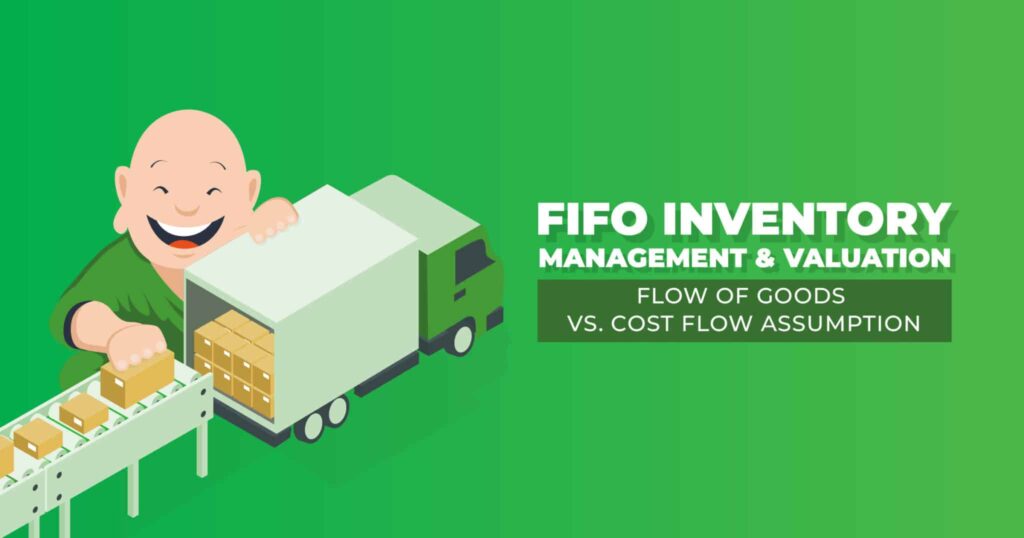Flow of Goods vs. Cost Flow Assumption
If you manage inventory, you’re familiar with the term FIFO, an acronym that stands for First In, First Out. Put simply, the items are sold in the order they are received in the store or warehouse. FIFO is the most common inventory management method for eCommerce businesses because selling the oldest units before the newer units helps ensure a consistent turnover of inventory.
What you may not realize is that FIFO is both an inventory management method and an accounting method—and, while similar, these are two completely different processes. What’s the difference? Stick with us to find out.
FIFO as an Inventory Management Method
Under the FIFO inventory method, when goods are received at a store, warehouse, or eCommerce fulfillment center, care is taken to move the older merchandise to the front of the shelf and to restock the shelf from the rear. That way, the oldest merchandise is picked first, whether by a customer in a brick and mortar store, a forklift at a wholesale distribution center, or a picker at an eCommerce order fulfillment center. In these examples, FIFO is the term used to describe the physical flow of inventory through a business.
The majority of businesses use the FIFO method for inventory management because it ensures a constant rotation of stock. Perishable and seasonable goods are sold before they expire or go out of style, which reduces inventory losses and the need for discounting.
The alternative to FIFO is the LIFO (Last In, Last Out) inventory method. Under the LIFO method, the newest units of inventory are stocked in front and picked off the shelf first. This ensures that your customers get the latest and greatest version of your product, even though it often means discounting or writing off older inventory. This method is often used by technology or electronics companies, where new versions of a product make the old version less desirable or obsolete. To reduce holding costs and dead stock, older inventory must be cleared out periodically. If your product has a predictable shelf life, FIFO is a better choice.
FIFO as an Inventory Valuation Method
In addition to being inventory management methods, FIFO and LIFO are also inventory valuation methods, or “cost flow assumptions,” that assign a cost (dollar value) to each unit of inventory. Since wholesale and manufacturing costs are changing constantly, two items with the same SKU sold on the same day may have cost the retailer or eCommerce business two different dollar amounts. Tracking inventory costs is critical because these numbers directly affect profitability—after all, profits are calculated by subtracting the cost of goods sold from revenues. Also, since unsold or ending inventory is considered an asset at the end of each year, its value must be calculated for financial reporting and tax purposes.
The FIFO inventory valuation method assumes that your inventory is being sold in the order it was received—the key word being “assumes.” With this cost flow assumption, the cost of the oldest unit on the shelf is attributed to the first unit sold that month and goes on the balance sheet as the cost of goods sold, regardless of which unit was pulled off the shelf first, or its actual cost. In fact, a company may use an entirely different method to physically manage their inventory, but use the FIFO accounting method to calculate the cost of goods sold and the value of ending inventory at year’s end.
Because the cost of purchased goods tends to rise over time, the FIFO method usually results in lower costs being allocated to the most recent units sold. The lower your cost of goods sold, the higher your profit margins and gross profits. In fact, under the FIFO method profits may be somewhat overstated during inflationary periods because there is a wider gap between costs and revenue. By maximizing gross profits and net income, the FIFO cost flow assumption makes a company’s profit and loss (P&L) statement look better at the end of the year, but may not accurately reflect rising costs, shrinking margins, or future profits.
Also, assuming costs are rising, companies that use the FIFO accounting method will see their ending inventory values rise over time. As older, less costly inventory is sold they are left with higher-value, more recently purchased goods on the shelf. While unsold inventory is considered an asset on the balance sheet, this metric is watched carefully. The optics aren’t quite as positive if too much of a company’s cash is tied up in unsalable inventory.
Advantages of the FIFO Cost Flow Assumption
- Since FIFO is the most commonly used inventory management method, many companies use the FIFO accounting method because it corresponds with the actual flow of goods.
- Attributing lower costs to current sales increases profit margins and helps reduce the pressure that rising costs put on operating income.
- Ending inventory values (assets) increase as costs rise.
- FIFO maximizes gross profits and net income at the end of the year, which is reflected in share prices and the overall valuation of the business.
Other Inventory Valuation Methods
FIFO is not the only cost flow assumption in use. The LIFO cost flow assumption assumes the newest inventory is being sold first. Under this method, the cost of the most recently purchased item is the cost attributed to the first item sold that month. Because higher costs are attributed to each unit, regardless of how long it’s been on the shelf or actual cost, gross profits and net income will be lower than under the FIFO method. Ending inventory values will also be lower, and are often undervalued during periods of inflation. Because lower gross profits usually mean lower taxable income, the LIFO method attracts companies that wish to lower their tax burden. The LIFO method is approved for use in the U.S. but prohibited under International Financial Reporting Standards (IFRS).
In addition to the FIFO and LIFO cost flow assumptions, companies can use the Weighted Average Method, which calculates the average cost of all units purchased during the year and uses that dollar value as COGS (Cost of Goods Sold) for each unit. A fourth method, the Specific Identification Method, tracks the actual cost of each unit. Because the specific method does not rely on any assumptions about the flow of goods, it is not considered a cost flow assumption, but simply a valuation method.
Companies can select from several inventory valuation methods, but once selected they are required to use the same method year after year to maintain consistency. U.S. companies are also required to use the same method for tax reporting as they use for financial reporting.
Software Makes Everything Easier
Whether you are a growing eCommerce business partnering with a 3PL or fulfillment center to fulfill orders, or a big box retailer with huge distribution centers, powerful software platforms make both FIFO inventory management and FIFO inventory valuation easier. A tech-forward 3PL like ShipMonk seamlessly integrates order and inventory management systems with accounting systems in real-time. That means inventory managers can track orders, automate reorders, and make more informed decisions while accountants have quick access to COGS and ending inventory values at tax time.
The Last Word on First In, First Out
As we’ve learned, FIFO is a term that is often used interchangeably to describe both the physical flow of goods through a company and the intangible flow of assets and expenses across a balance sheet. It can be confusing when you aren’t sure which “flow” is being discussed. (Hint: if it’s an accountant talking, it’s probably the latter.)
But whether you’re managing physical goods or costs, FIFO is the most common method to use. If your products have a predictable shelf life and don’t easily become obsolete, FIFO is the logical choice for inventory management. It is also the most commonly used inventory accounting method because under the FIFO method costs logically follow the flow of goods. Of course, plenty of companies choose other accounting methods, but they are the exceptions rather than the rule. At the end of the year, FIFO presents your company in the best light—maximizing profits, net income, and asset values. Please note, as always you’ll want to consult a business tax professional to determine the best action to take when it comes to accounting for your inventory management and valuations.
To see how a tech-forward 3PL can make inventory management and calculating inventory costs easier, contact a fulfillment expert at ShipMonk today.





